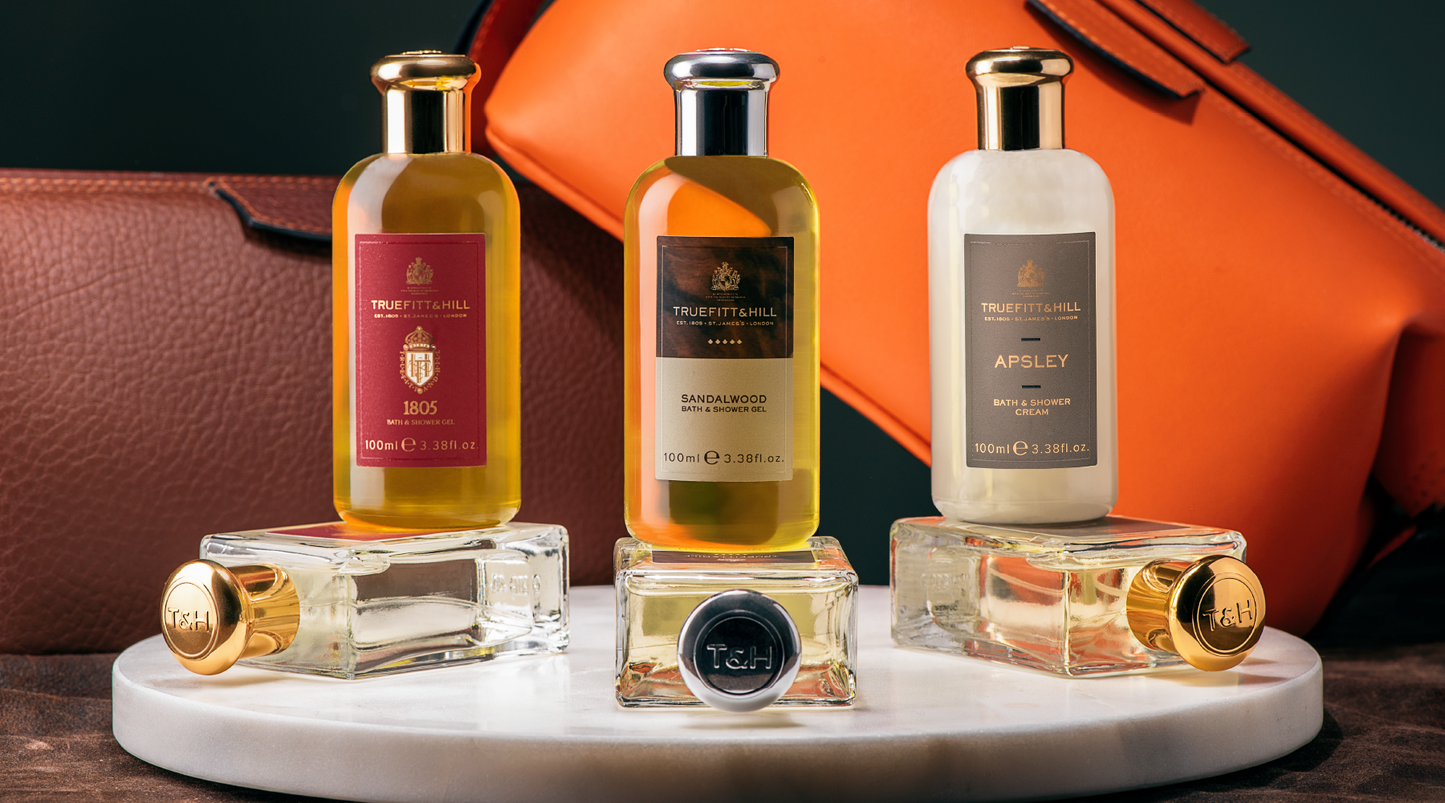
It’s a new year and it’s time to get out into the world. Life has been constrained and inward-looking over the last two years of the pandemic, and we’re hoping that in 2022we will be, once again, able to broaden our horizons and experience the freedom of the open road.
Setting forth from your home base, whether for business travel or holidays, involves portable baggage, which ensures that our clothing and grooming essentials are always to hand. We’ve been pondering this very basic need and looking at the history of luggage.Young British gentlemen who embarked on the ‘grand tour’ of Europe in the late 18th century travelled in style, and were frequently accompanied by an entire carriage dedicated to extensive wardrobes and even including indispensable items of furniture. Even a more modest Victorian gentleman traveller would have totally eschewed today’s portable cases. Travelling was the prerogative of the upper classes, who toured the world on steamships and packed a vast array of ‘essential’ items in bulky trunks, built of wood and leather on robust iron frameworks, which were constructed to withstand heavy seas and the danger of water damage. These behemoths were carried on to steamships and trains, or conveyed into hotels, by fleets of porters and bellhops. The traveller totally repudiated responsibility for his own luggage, but this freedom came at a very high price, which few could afford. Recognisably modern, and portable, suitcases began to appear at the end of the 19th century. Travel was becoming more widely available for the masses, and they were roaming far and wide – making day trips to seaside resorts such as Brighton and Blackpool, or venturing further afield to stay in huge resort hotels in countries such as Switzerland, Germany and Italy. Armed with Baedeker’s pocket-sized tourist guides (first published in 1827), an indispensable Bradshaw’s guide to Europe’s railway network and one of the new-fangled portable suitcases, late Victorian tourists began to explore the world. It was a golden age of travel, which was no longer the exclusive preserve of the wealthy and leisured classes.By today’s standards, the first suitcases were bulky and unwieldy. They were constructed of leather, wicker or thick rubber cloth, which was stretched over a rigid frame. Nevertheless, these hefty pieces of luggage were seen as symbols of freedom and opportunity, signifiers of a society that was both socially, and physically mobile. Inevitably, suitcases mutated to mirror the form of transportation that was most dominant. As trains were gradually supplanted by cars, suitcases became lighter and cheaper. A cardboard suitcase could easily be lodged in the car boot and was perfectly adequate for a motorist’s needs.
Recognisably modern, and portable, suitcases began to appear at the end of the 19th century. Travel was becoming more widely available for the masses, and they were roaming far and wide – making day trips to seaside resorts such as Brighton and Blackpool, or venturing further afield to stay in huge resort hotels in countries such as Switzerland, Germany and Italy. Armed with Baedeker’s pocket-sized tourist guides (first published in 1827), an indispensable Bradshaw’s guide to Europe’s railway network and one of the new-fangled portable suitcases, late Victorian tourists began to explore the world. It was a golden age of travel, which was no longer the exclusive preserve of the wealthy and leisured classes.By today’s standards, the first suitcases were bulky and unwieldy. They were constructed of leather, wicker or thick rubber cloth, which was stretched over a rigid frame. Nevertheless, these hefty pieces of luggage were seen as symbols of freedom and opportunity, signifiers of a society that was both socially, and physically mobile. Inevitably, suitcases mutated to mirror the form of transportation that was most dominant. As trains were gradually supplanted by cars, suitcases became lighter and cheaper. A cardboard suitcase could easily be lodged in the car boot and was perfectly adequate for a motorist’s needs.
With the advent of air travel, luggage evolved yet again. Limited storage capacity on aeroplanes meant that bags were restricted to certain sizes, and also needed to be robust enough to withstand rough treatment by baggage handlers. Passengers were obliged to walk, with their luggage, through increasingly extensive airports, and wheels and extendible handles turned bags into trolleys, ensuring that no heavy lifting was required. Fully equipped with a suitcase or wheelie bag and ready to hit the open road, the next pressing question is: what should we pack? As well as supplies of clothing, it is imperative that our bags also contain our grooming and hygiene essentials. These small, and often fragile items clearly need to be contained within their own, protective container: the ubiquitous wash bag. This utilitarian item of luggage also has an interesting history. In the 18th and 19th centuries, gentlemen would have been the proud owners of magnificent dressing cases, containing bottles and jars of colognes and aftershave and items such as a razor and leather strop, scissors, a toothbrush, mirror and hairbrush. Frequently these boxes were made of exotic inlaid woods, and were lined with silk or velvet. Glass jars were often bespoke items made of cut glass, with silver stoppers. These beautiful objects were aesthetically pleasing status symbols, considered to be an essential feature of the distinguished gentleman’s equipment.
This utilitarian item of luggage also has an interesting history. In the 18th and 19th centuries, gentlemen would have been the proud owners of magnificent dressing cases, containing bottles and jars of colognes and aftershave and items such as a razor and leather strop, scissors, a toothbrush, mirror and hairbrush. Frequently these boxes were made of exotic inlaid woods, and were lined with silk or velvet. Glass jars were often bespoke items made of cut glass, with silver stoppers. These beautiful objects were aesthetically pleasing status symbols, considered to be an essential feature of the distinguished gentleman’s equipment.
In the late 19th century, when steamships and steam trains opened up remote parts of the world and tourism became more commonplace, travelling dressing cases were introduced. These were heavy duty leather holdalls with a wooden frame, which opened at the top and sides, in the manner of an old fashioned ‘doctor’s bag’, to reveal an array of bottles, brushes, mirrors, manicure and writing sets. Frequently given as a 21st birthday present, these elaborate bags were made to order and were frequently adorned with monograms and coronets and endowed with bespoke fittings, such as silver and gold mountings, engraved accessories, and cut-glass bottles. Nevertheless, these leather holdalls were unwieldy and heavy, requiring the services of porters and servants. It is scarcely surprising, therefore, that the mass movement of troops at the beginning of World War I demanded a more pragmatic option. Charles Doppelt was a German immigrant to the US who manufactured sturdy leather wash bags for the US military. These handy items were dubbed ‘Dopp bags’ or even ‘Dopps’ and have continued to be manufactured ever since in the US.
The notion of a portable leather carrying case for men’s toiletries soon caught on, and various luxury manufacturers began to create more refined, and aesthetically pleasing versions of the original army Dopp bag. Truefitt & Hill’s Gentleman’s leather wash bag is made of vegetable-dyed calfskin, and fully lined with textile leather, which can be easily wiped down and kept clean. They are offered in a stylish range of colours: olive green, orange, Havana brown and blue, and are smartly embossed with the Truefitt & Hill logo. These beautiful bags cleverly marry the beauty and perfectionism of the traditional dressing case, with the rugged practicality of the Dopp bag.  A globe-trotting gentleman has one final priority when packing his bag: his shaving kit. Rather than letting your shaving brush and razor rattle around loose in your wash bag, treat these vital tools with the respect they deserve, and transport them in Truefitt & Hill’s leather Razor and Brush Travel Holder. They will be snugly encased, protected and instantly accessible.If you’re a truly footloose flier, who evades the delays and inconveniences caused by baggage checks and cumbersome luggage, you will be travelling light, with a carry-on bag. We are still subject to a 100ml limit on liquids when we include them in our cabin baggage, but Truefitt & Hill’s Travel Collection range will ensure that you will not have to compromise on quality. Your favourite prerequisites – Replenishing Conditioner, Shampoo, Bath & Shower Gel – are all available in handy 100ml bottles. This will ensure that, wherever you go, you will be able to take your home hygiene routine with you.
A globe-trotting gentleman has one final priority when packing his bag: his shaving kit. Rather than letting your shaving brush and razor rattle around loose in your wash bag, treat these vital tools with the respect they deserve, and transport them in Truefitt & Hill’s leather Razor and Brush Travel Holder. They will be snugly encased, protected and instantly accessible.If you’re a truly footloose flier, who evades the delays and inconveniences caused by baggage checks and cumbersome luggage, you will be travelling light, with a carry-on bag. We are still subject to a 100ml limit on liquids when we include them in our cabin baggage, but Truefitt & Hill’s Travel Collection range will ensure that you will not have to compromise on quality. Your favourite prerequisites – Replenishing Conditioner, Shampoo, Bath & Shower Gel – are all available in handy 100ml bottles. This will ensure that, wherever you go, you will be able to take your home hygiene routine with you.
The ease and convenience of travelling abroad has certainly been transformed since the days of steamer trunks, dressing cases and porters. But quality travelling accessories have never gone out of fashion.
